
Franciscans in Cashel and Emly
¦ History Index ¦
¦ Main Page ¦
Franciscan Abbeys - Friaries - were built throughout Ireland and were supported by local people. While the Franciscans were in Ireland by 1224, there is no proof that friaries were established before 1231-3. They were effectively the parish churches of ordinary folk, with simple naves accommodating them. There were almost as many friaries as other religious houses by the time of the Reformation.
The Third Order Regular of Saint Francis undertook particularly pastoral and educational roles. Having arrived in Ireland by 1426, they had forty-six houses by 1536 with one in Hospital, County Limerick. Kileenagallive, near Emly, was founded for the Third Order by King Edward IV before 1461 and in use by the First Order from 1615 to 1625, and again from 1676 until 1690
Otherwise known as Celtic site, Derrynaflan appears in official Franciscan documents from 1676 to 1724. While the location of the house so named is unclear, it is thought to be the Derrynaflan as known locally because of its Cashel association.
There follow some details of the Franciscan foundations in Galbally, Cashel and Thurles.
Other than the Franciscan Missionaries of the Divine Motherhood, there are no Franciscan communities in the Archdiocese of Cashel and Emly today.
Moor Abbey

Donach Cairbreach Ua'Briain founded this friary in Galbally during the first decade of the thirteenth century. Only the main church, built in 1471, survives. Quite apart from the murder of three friars of the community in the
1570's, violence was often visited upon the building. It was burnt in 1472, and again in 1569. Sir Henry Sidney had it sacked in 1570. Demolition was attempted by the police in 1921.
The Friary had a long, if broken, habitation. The grant of the Abbey to the Earl of Desmond in 1540 allowed it to function until by Sir Humphrey Gilbert burnt it in 1569. After the disruption mentioned, the Franciscans returned in 1645 until they were expelled during the campaign of Cromwellian's soldiers. They returned in 1658, staying until 1684 and were back in Moor Abbey in 1688. They stayed until 1748 when they left after a dispute with the Vicar General of Emly, James Butler (then Parish Priest of Galbally and later Archbishop). The community moved to Mitchelstown where the last friar died 1804.
Franciscan Architecture
Moor Abbey is a typical Franciscan structure.The belfry is of the usual Franciscan kind in its location (off-centre to the East) and proportions. Only in Muckross Friary in Kerry does a Franciscan tower span the width of the aisle. The horizontal string-courses are of the simple decoration favoured by the Franciscans' builders. Other examples of this type suggest that the top of the tower would have been crenellated.
It is possible that many of the conventual structures were of timber and so are (as yet) undetected. Excavations have indicated the location of the scaffold used in the construction of the remaining building..
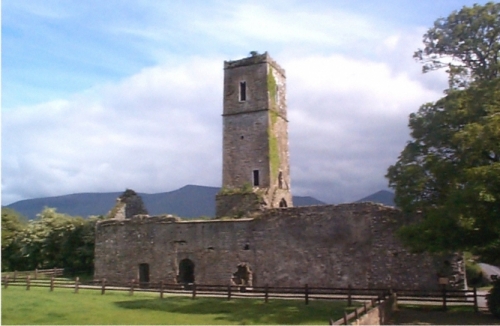
¦ History Index ¦
¦ Main Page ¦
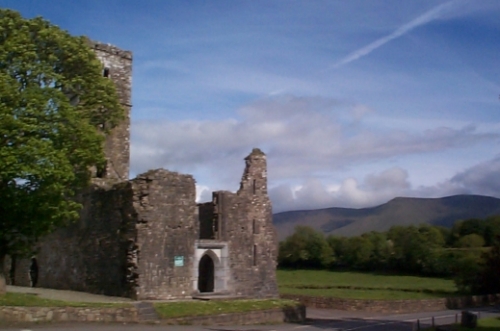
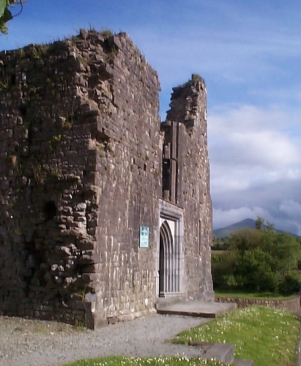
Franciscans in Cashel
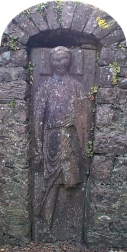
¦ Top of Page ¦
¦ History Index ¦
¦ Main Page ¦
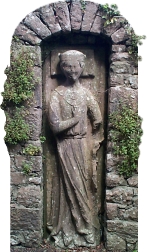 |
The effigies shown here are two of four which are preserved in Cashel, now set into the old town walls adjacent to the Church of Ireland Cathedral. Originally in the Franciscan Friary, they may be the burial slabs of the benefactor Sir William Hackett and of his wife and family.
After the Reformation the Friary properties were granted to the Protestant bishop and their use was allowed to be continued until 1550.
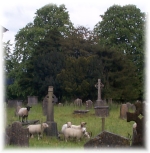
¦ Top of Page ¦
¦ History Index ¦
¦ Main Page ¦
Myler Magrath, was a Franciscan friar who was consecrated Bishop of Down and Conor by the Pope in 1565. He submitted to the Act of Supremacy in 1567 and was appointed Protestant Archbishop of Cashel in 1571.
Among his first displays of fealty was the arrest of two of the Franciscans of Cashel. This aroused considerable indignation when James Fitzmaurice Fitzgerald, 'Captain of Desmond', wrote a threatening letter from the Glen of Aherlow demanding their release. His associate, Edward Butler, effected their release during a subsequent raid on Cashel. The former-Franciscan's treatment of his one-time confreres is just one of many colourful incidents in his long life.
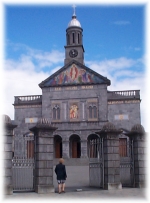 |
The Friars returned to Cashel in 1618, remaining until the sacking of the city by Lord Inchiquin on 13 September 1647. Among those killed at that time were Vicars Choral Edward Stapleton, (Chancellor) and Theobald Stapleton. The elderly and infirm Thomas Morrissey, a priest of Cashel and Franciscan Tertiary, was also put to death.
John Kearney was born in Cashel in 1619. He joined the Franciscans and studied in Louvain where he was ordained in 1642. On return to Ireland he was captured but escaped to minister in Cashel and Waterford. He was charged with functioning as a priest and was hanged on 11 March 1653.
The Franciscans returned to Cashel in 1658 and continuued residence there until moving to Thurles.
The Catholic Church currently in use in Cashel stands on the site of the Friary.
Franciscans in Thurles

A scion of this family, Theobald Mathew, would add to the contribution of the Franciscan family in his Temperance Crusade and a great-grand-nephew, David, of his would serve Westminster Archdiocese as an auxiliary bishop in the earlier part of the twentieth century
The Franciscans had moved to the town by 1740 and continued to live in the house provided by the Mathews in which they had a small oratory. They did not have a public church but assisted in the Cathedral and served as chaplains to the Workhouse. The Thurles Franciscan house was closed 1892.
¦ Top of Page ¦
¦ History Index ¦
¦ Main Page ¦
¦
|